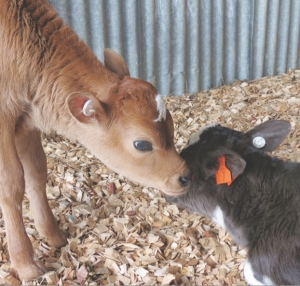It can be prevented by strategies like ensuring that heifers are well grown prior to and after joining, making certain that cows and heifers calve in good condition, neither too fat or too thin, managing the calves’ birth weights by using calving ease or sexed semen is a valuable tool, and ensuring supervision of calving cows is important.
Knowing what is “normal” and when to assist a calving cow is extremely important. Both front feet, followed by the head is a normal presentation. The quicker that you are able to identify that the delivery is not progressing, or that the calf is malpresented or oversized, the better the chance of a successful delivery.
Vets have a few things in our bag of tricks that are useful for the really difficult deliveries, but the large majority of calves that require assistance can be delivered without any special equipment. Calving jacks, pulleys or a variety of contraptions are great as a calving aid, though it must be remembered to use force judiciously. Just because you can pull that hard, doesn’t always mean that you should.
A question that I am frequently asked is: “How do you know if a calf can be pulled?” Generally speaking, if a calf can be pulled up into the birth canal, and I can slide my arm down beside the head and shoulder, I would consider that I have a good chance of delivering that calf.
I prefer calving ropes or lo-trauma calving straps to chains, but chains are more hygienic and are easier to keep clean. I frequently find that by simply using a soft head snare to keep the head up and the neck extended, I can easily deliver otherwise ‘unpullable’ calves.
Another frequent error that I see farmers make is not using lubricant. Once the calf is dry, or if the cow’s birth canal is tight, trying to pull the calf without enough lubrication will cause tearing and bruising. Obstetrical lubricant is inexpensive and makes the process better for the cow and the operator.
Cleanliness is another real deficiency I observe in many cases of calving assistance. Using clean water, with a non-irritating disinfectant agent to clean around the back end, tying the tail to the side, (or having an assistant hold it for you), and wearing disposable AI gloves whenever possible will dramatically reduce the amount of contamination of the birth canal with dirt and faeces and greatly reduce the risk of Metritis.
Calving paralysis is a serious complication of either overly vigorous assistance or a hiplock occurring in an unobserved calving. Hiplock can often be prevented or relieved by rotating the calf by 90 degrees to present the narrowest profile of the calf’s hips to the cow’s pelvis as the calf is delivered.
Whenever a lot of manipulation of the calf is required, it is usually best to call the vet sooner rather than later. Once the calf is dead and the reproductive tract is contaminated or damaged and is swollen and dry, the job is much harder, and the outcome poorer.
The best advice that I can give regarding a calving cow is this: Remember the ‘20 minute rule’.
If you have been working on a calving cow for 20 minutes, and have made no progress, stop, reassess, call for assistance or try a new approach.
Ensure that the cow is safely and adequately restrained. Never pull on only one leg, never pull harder than is necessary; patience and lubrication will prevent injuries.
Promptly treat any maternal tears or injuries and providing excellent nursing care in addition to anti-inflammatories when cows have maternal paralysis will give the best welfare and economic outcomes.
Calving assistance is as much art as science, Experience is the greatest teacher, but sticking to the ‘20 minute rule’ will mean that even an inexperienced operator will slowly improve their skill level without too many disasters along the way.
Veterinarians have access to uterine relaxants and epidural anaesthesia that makes the process safer for the cow and the operator.
• Rob Bonanno is a partner in the Shepparton Veterinary Clinic, Victoria, Australia and a past president of the Australian Cattle Veterinarians Association.









